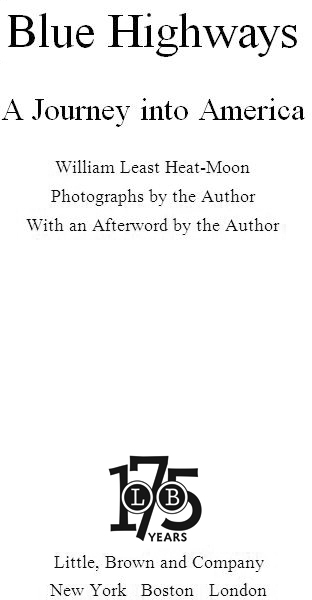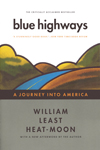Blue Highways
Authors: William Least Heat-Moon



In accordance with the U.S. Copyright Act of 1976, the scanning, uploading, and electronic sharing of any part of this book without the permission of the publisher constitute unlawful piracy and theft of the author’s intellectual property. If you would like to use material from the book (other than for review purposes), prior written permission must be obtained by contacting the publisher at [email protected]. Thank you for your support of the author’s rights.
This book is for the wife of the Chief and for the Chieftain too.
In love.
O
N
the old highway maps of America, the main routes were red and the back roads blue. Now even the colors are changing. But in those brevities just before dawn and a little after dusk—times neither day nor night—the old roads return to the sky some of its color. Then, in truth, they carry a mysterious cast of blue, and it’s that time when the pull of the blue highway is strongest, when the open road is a beckoning, a strangeness, a place where a man can lose himself.
Eastward

B
EWARE
thoughts that come in the night. They aren’t turned properly; they come in askew, free of sense and restriction, deriving from the most remote of sources. Take the idea of February 17, a day of canceled expectations, the day I learned my job teaching English was finished because of declining enrollment at the college, the day I called my wife from whom I’d been separated for nine months to give her the news, the day she let slip about her “friend”—Rick or Dick or Chick. Something like that.
That morning, before all the news started hitting the fan, Eddie Short Leaf, who worked a bottomland section of the Missouri River and plowed snow off campus sidewalks, told me if the deep cold didn’t break soon the trees would freeze straight through and explode. Indeed.
That night, as I lay wondering whether I would get sleep or explosion, I got the idea instead. A man who couldn’t make things go right could at least go. He could quit trying to get out of the way of life. Chuck routine. Live the real jeopardy of circumstance. It was a question of dignity.
The result: on March 19, the last night of winter, I again lay awake in the tangled bed, this time doubting the madness of just walking out on things, doubting the whole plan that would begin at daybreak—to set out on a long (equivalent to half the circumference of the earth), circular trip over the back roads of the United States. Following a circle would give a purpose—to come around again—where taking a straight line would not. And I was going to do it by living out of the back end of a truck. But how to begin a beginning?
A strange sound interrupted my tossing. I went to the window, the cold air against my eyes. At first I saw only starlight. Then they were there. Up in the March blackness, two entwined skeins of snow and blue geese honking north, an undulating W-shaped configuration across the deep sky, white bellies glowing eerily with the reflected light from town, necks stretched northward. Then another flock pulled by who knows what out of the south to breed and remake itself. A new season. Answer: begin by following spring as they did—darkly, with neck stuck out.
T
HE
vernal equinox came on gray and quiet, a curiously still morning not winter and not spring, as if the cycle paused. Because things go their own way, my daybreak departure turned to a morning departure, then to an afternoon departure. Finally, I climbed into the van, rolled down the window, looked a last time at the rented apartment. From a dead elm sparrow hawks used each year came a high
whee
as the nestlings squealed for more grub. I started the engine. When I returned a season from now—if I did return—those squabs would be gone from the nest.
Accompanied only by a small, gray spider crawling the dashboard (kill a spider and it will rain), I drove into the street, around the corner, through the intersection, over the bridge, onto the highway. I was heading toward those little towns that get on the map—if they get on at all—only because some cartographer has a blank space to fill: Remote, Oregon; Simplicity, Virginia; New Freedom, Pennsylvania; New Hope, Tennessee; Why, Arizona; Whynot, Mississippi. Igo, California (just down the road from Ono), here I come.
A
PLEDGE
: I give this chapter to myself. When done with it, I will shut up about
that
topic.
Call me Least Heat-Moon. My father calls himself Heat-Moon, my elder brother Little Heat-Moon. I, coming last, am therefore Least. It has been a long lesson of a name to learn.
To the Siouan peoples, the Moon of Heat is the seventh month, a time also known as the Blood Moon—I think because of its dusky midsummer color.
I have other names: Buck, once a slur—never mind the predominant Anglo features. Also Bill Trogdon. The Christian names come from a grandfather eight generations back, one William Trogdon, an immigrant Lancashireman living in North Carolina, who was killed by the Tories for providing food to rebel patriots and thereby got his name in volume four of
Makers of America
. Yet to the red way of thinking, a man who makes peace with the new by destroying the old is not to be honored. So I hear.
One summer when Heat-Moon and I were walking the ancestral grounds of the Osage near the river of that name in western Missouri, we talked about bloodlines. He said, “Each of the people from anywhere, when you see in them far enough, you find red blood and a red heart. There’s a hope.”
Nevertheless, a mixed-blood—let his heart be where it may—is a contaminated man who will be trusted by neither red nor white. The attitude goes back to a long history of “perfidious” half-breeds, men who, by their nature, had to choose against one of their bloodlines. As for me, I will choose for heart, for spirit, but never will I choose for blood.
One last word about bloodlines. My wife, a woman of striking mixed-blood features, came from the Cherokee. Our battles, my Cherokee and I, we called the “Indian wars.”
For these reasons I named my truck Ghost Dancing, a heavy-handed symbol alluding to ceremonies of the 1890s in which the Plains Indians, wearing cloth shirts they believed rendered them indestructible, danced for the return of warriors, bison, and the fervor of the old life that would sweep away the new. Ghost dances, desperate resurrection rituals, were the dying rattles of a people whose last defense was delusion—about all that remained to them in their futility.
A final detail: on the morning of my departure, I had seen thirty-eight Blood Moons, an age that carries its own madness and futility. With a nearly desperate sense of isolation and a growing suspicion that I lived in an alien land, I took to the open road in search of places where change did not mean ruin and where time and men and deeds connected.
T
HE
first highway: Interstate 70 eastbound out of Columbia, Missouri. The road here follows, more or less, the Booneslick Trail, the initial leg of the Oregon Trail; it also parallels both the southern latitude of the last great glacier in central Missouri as well as the northern boundary of the Osage Nation. The Cherokee and I had skirmished its length in Missouri and Illinois for ten years, and memory made for hard driving that first day of spring. But it was the fastest route east out of the homeland. When memory is too much, turn to the eye. So I watched particularities.
Item: a green and grainy and corrupted ice over the ponds.
Item: blackbirds, passing like storm-borne leaves, sweeping just above the treetops, moving as if invisibly tethered to one will.
Item: barn roofs painted
VISIT ROCK CITY—SEE SEVEN STATES
. Seven at one fell swoop. People loved it.
Item: uprooted fencerows of Osage orange (so-called hedge apples although they are in the mulberry family). The Osage made bows and war clubs from the limbs; the trunks, with a natural fungicide, carried the first telegraph lines; and roots furnished dye to make doughboy uniforms olive drab. Now the Osage orange were going so bigger tractors could work longer rows.
At High Hill, two boys were flying gaudy butterfly kites that pulled hard against their leashes. No strings, no flight. A town of surprising flatness on a single main street of turn-of-the-century buildings paralleling the interstate, High Hill sat golden in a piece of sunlight that broke through. No one moved along the street, and things held so still and old, the town looked like a museum diorama.
Eighty miles out, rain started popping the windshield, and the road became blobby headlights and green interstate signs for this exit, that exit.
LAST EXIT TO ELSEWHERE.
I crossed the Missouri River not far upstream from where Lewis and Clark on another wet spring afternoon set out for Mr. Jefferson’s
“terra incognita.”
Then, to the southeast under a glowing skullcap of fouled sky, lay St. Louis. I crossed the Mississippi as it carried its forty hourly tons of topsoil to the Louisiana delta.
The tumult of St. Louis behind, the Illinois superwide quiet but for the rain, I turned south onto state 4, a shortcut to I-64. After that, the 42,500 miles of straight and wide could lead to hell for all I cared; I was going to stay on the three million miles of bent and narrow rural American two-lane, the roads to Podunk and Toonerville. Into the sticks, the boondocks, the burgs, backwaters, jerkwaters, the wide-spots-in-the-road, the don’t-blink-or-you’ll-miss-it towns. Into those places where you say, “My god! What if you lived here!” The Middle of Nowhere.
The early darkness came on. My headlamps cut only a forty-foot trail through the rain, and the dashboard lights cast a spectral glowing. Sheet lightning behind the horizon of trees made the sky look like a great faded orange cloth being blown about; then darkness soaked up the light, and, for a moment, I was blinder than before.

